-
Paper Information
- Next Paper
- Previous Paper
- Paper Submission
-
Journal Information
- About This Journal
- Editorial Board
- Current Issue
- Archive
- Author Guidelines
- Contact Us
Geosciences
p-ISSN: 2163-1697 e-ISSN: 2163-1719
2013; 3(2): 48-52
doi:10.5923/j.geo.20130302.02
S velocity Structure between the Hypocenter of December 30, 1995 Earthquake in Alaska and Observational Stations DPC, COR, DGR and ERM
Bagus Jaya Santosa
Jurusan Fisika, Fmipa Its, Jln Arif Rahman Hakim 1, Surabaya, 60111, Indonesia
Correspondence to: Bagus Jaya Santosa, Jurusan Fisika, Fmipa Its, Jln Arif Rahman Hakim 1, Surabaya, 60111, Indonesia.
| Email: |  |
Copyright © 2012 Scientific & Academic Publishing. All Rights Reserved.
The S velocity structure in Western Alaska is investigated by seismogram fitting due the 12/30/1995 earthquake at several observation stations around it, which are Dobruzka, Czech Republic (DPC); Domenigeni Valley Reservoir, CA, USA (DGR); Corvallis, OR, USA (COR); and Erimo, Hokkaido, Japan (ERM), in time domain and three components simultaneously. Seismogram synthetic is calculated using GEMINI program, yielding a complete seismogram, where program’s input is a radial, symmetric and transversal isotropic earth models and the earthquake’s CMT solution. Seismogram comparison is executed in time domain, and prior to it is imposed by a low-pass filter of 20 mHz. There are significant discrepancies on the waveforms from S wave until surface wave. Seismogram fitting between the measured and the synthetic seismogram is conducted. The fitting is obtained through altering the gradient of βh speed in upper mantle and values of zeroed order coefficients of speed functions in the earth mantle layers till a depth of 670 km. The resulted fitting is obtained in Love, Rayleigh and S waveforms. The corrected earth models show that the S speed structure has negative anomaly in the upper mantle.
Keywords: S Velocity Structure, Waveform Analysis, 3 Components
Cite this paper: Bagus Jaya Santosa, S velocity Structure between the Hypocenter of December 30, 1995 Earthquake in Alaska and Observational Stations DPC, COR, DGR and ERM, Geosciences, Vol. 3 No. 2, 2013, pp. 48-52. doi: 10.5923/j.geo.20130302.02.
1. Introduction
- Alaska area, which is located on the North East of Pacific Ocean Ring of Fire, is an area of tectonic in front zone of plate collision between the Pacific plate and the North American continent plate in the form of subducting Ocean plate below the continental plate. According to Ref.[1], at subduction areas in Alaska, due to the collisions between continental and ocean plates, the structure of the soil that experience compression (side Ocean plate) will show positive speed anomalies. On the contrary, observed velocity of the continental shelf area shows negative anomalies. This kind of velocity structure is obtained by inverting P wave travel time data [2—4]. This research interprets S velocity structure, which is obtained from the shear wave, in the front zone of the same subduction zone through seismogram analysis in time domain and three components of ground movement.Quantitative analysis that can be performed on a seismogram is measuring the arrival time of wave phases and dispersion analysis on surface waves. The most easily obtainable data is P wave arrival time, because it is the first break. Ref.[1] use P wave arrival time data in their research. S waves arrival time on a station with small epicenter distance is more difficult to measure, because it has longer period and not a first-breaks and is located in a noisy environment. The standard isotropic Earth Models PREM[5] and IASP91[6], are often used as a reference in the regional seismological research as an initial Earth model. Most seismologists have interpret the model Earth in this research area (Alaska) using travel time data and Rayleigh wave dispersion data only based on one component z[7],[4], [8—11]. In this study the Earth model in front of subduction zone in Alaska was examined through seismogram comparison of 12/30/1995, coded using old CMT format as B123095A earthquake which hypocenter is located in Alaska subduction zone, in the time domain, the waveform of S, Love and Rayleigh surface waves will be observed. The Earth model obtained by processing travel time data was retested whether it can result synthetic seismogram which resembles the observed one. The entirety of the information contained in the seismogram was used to test the Earth models.
2. Research Methodology
- The earthquakes analysed in this study took place in the centre of Alaska, USA. Seismogram Data is obtained from Databank Centre (see http://dmc.iris.washington.edu), where data is accessed through the webpage. Earthquake produces ground movement, which is recorded by a station in the direction of the three local Cartesian components (North-South, East-West and Z vertical), in the receiving station.The observational stations are located at DGR, DPC, COR and ERM. The ground movement is a complex 3-dimensional space. To alter the components of the ground movement into P-SV and SH wave, then the horizontal plane formed by the local N-S and E-W axes at receiving stations must be rotated, such that local 'North' of the observation station is directed at small arc from the observation station to the earthquake epicentre (back-azimuth). Redirection is required to satisfy the wave propagation theorem, that the complex ground movement can be described into P-SV wave in z, r and SH components in the t component.
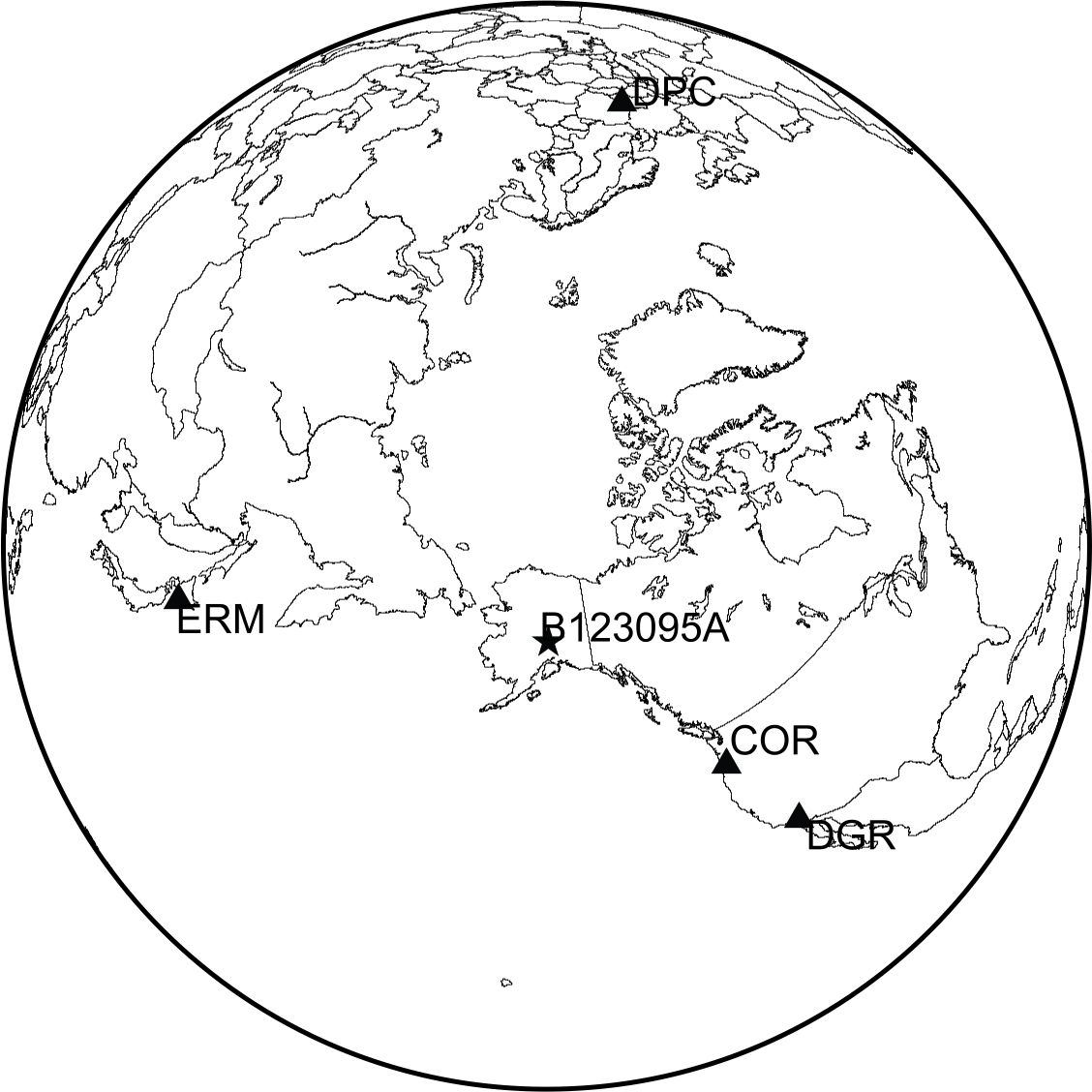 | Figure 1. The locations of DGR, DPC, COR, ERM observation stations and earthquake epicenter |
3. Discussion and Analysis
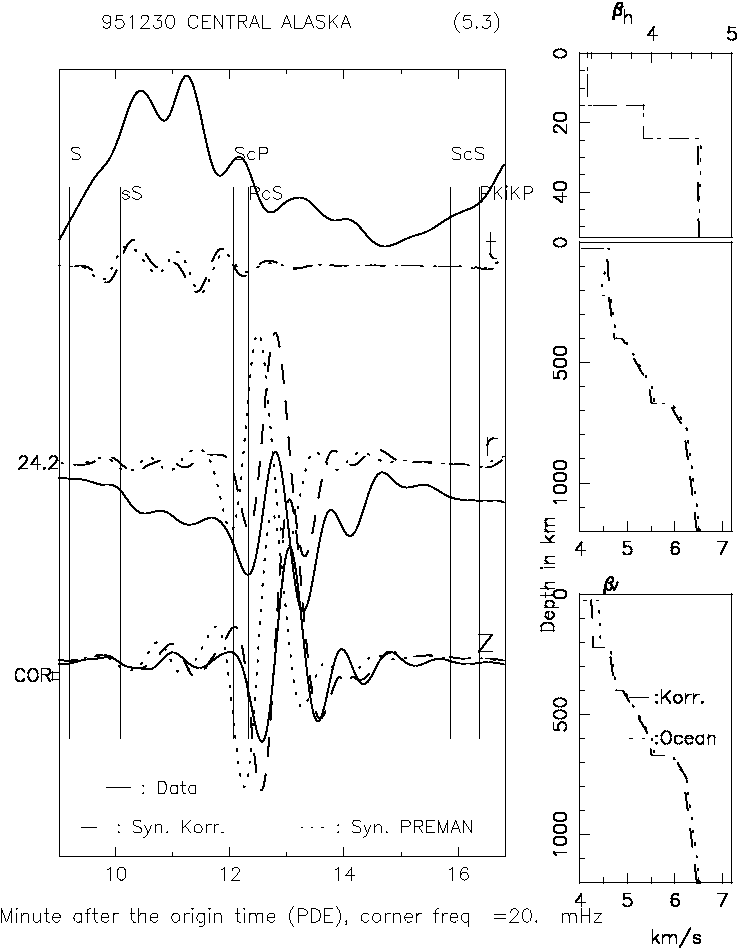 | Figure 2. Seismogram analysis and fitting of B123095A earthquake at COR station |
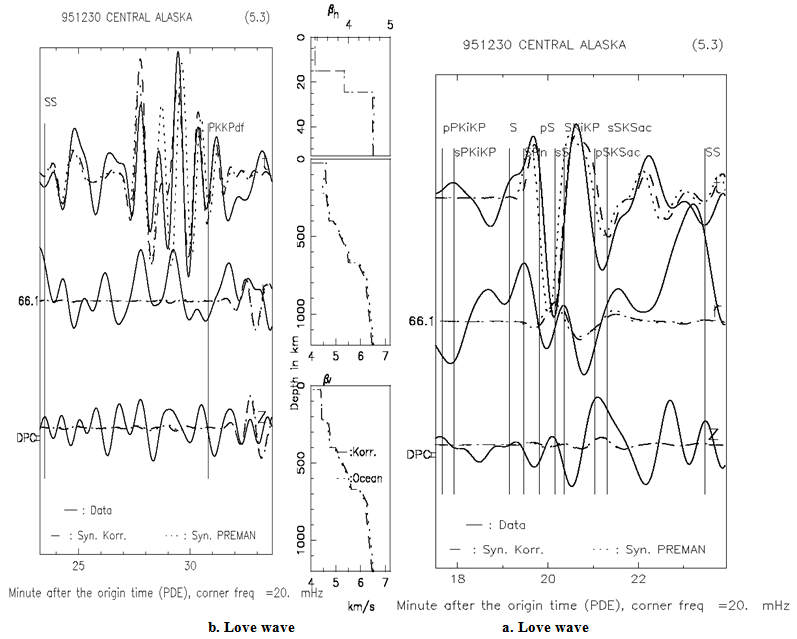 | Figure 3. Seismogram analysis and fitting of B123095A earthquake on DPC station, time window a. surface wave and b. S wave |
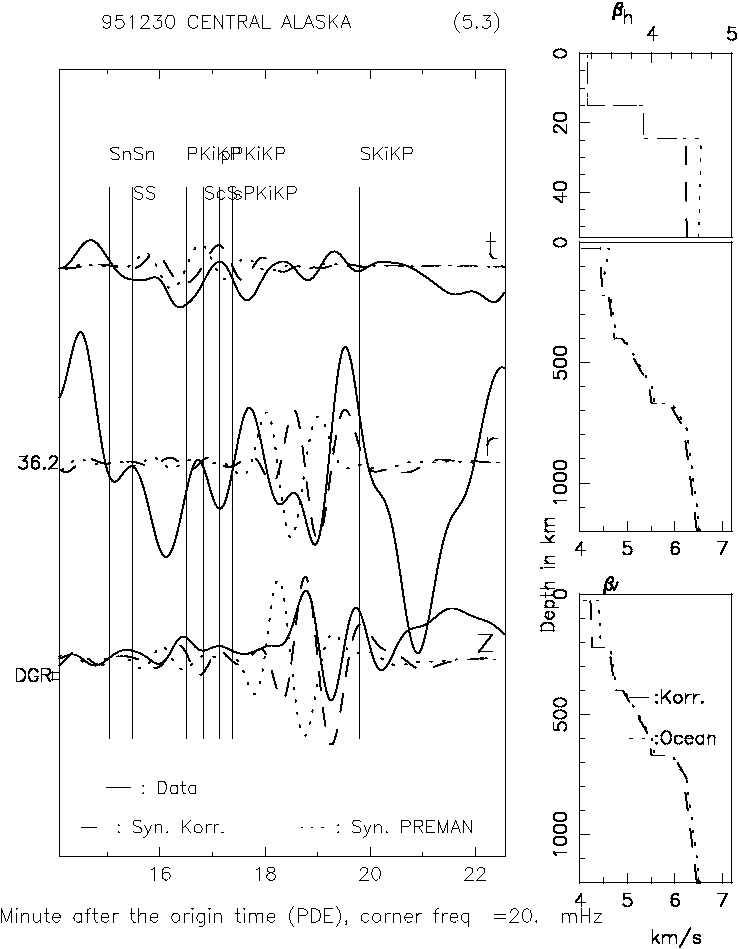 | Figure 4. Seismogram analysis and fitting of B123095A earthquake on DGR station |
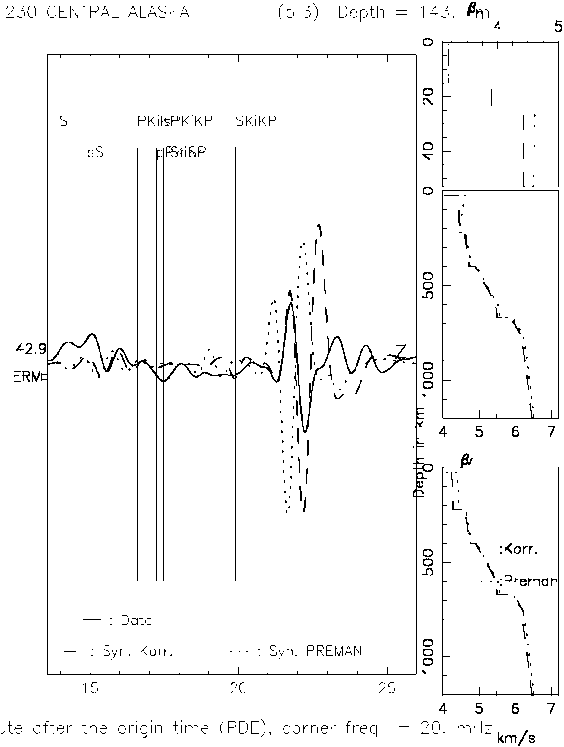 | Figure 5. Seismogram analysis and fitting of B123095A earthquake on ERM station |
4. Conclusions
- This research carries out seismogram analysis in time domain and the three Cartesian components simultaneously, to obtain more complete information in the seismogram, compared to the analysis using only wave phase travel time and analysis of dispersion.Simulation and comparison of seismogram can only be made up to 20 mHz frequency, because significant discrepancies has been observed on surface waves and S waves. At higher frequencies, e.g. with corner frequency of 45 mHz, strong discrepancies in the waveform shows Earth model that deviates from the supposed model.On 20 mHz corner frequency, surface waves propagate to a depth equal to the upper mantle, thus fitting can be obtained by changing the velocity structure until upper mantle layer, where changes are made on a velocity gradient with respect to depth. Changes in the upper mantle structure did not bring improvements to the S wave phase. Further correction was carried out on the shear wave velocity propagation structure on deeper Earth layers, until a good fitting obtained on S wave. Results of this research show that the S velocity structure in front zone of the subduction zone in Alaska subsurface also has negative anomalies, such as P velocity anomaly.
 Abstract
Abstract Reference
Reference Full-Text PDF
Full-Text PDF Full-text HTML
Full-text HTML